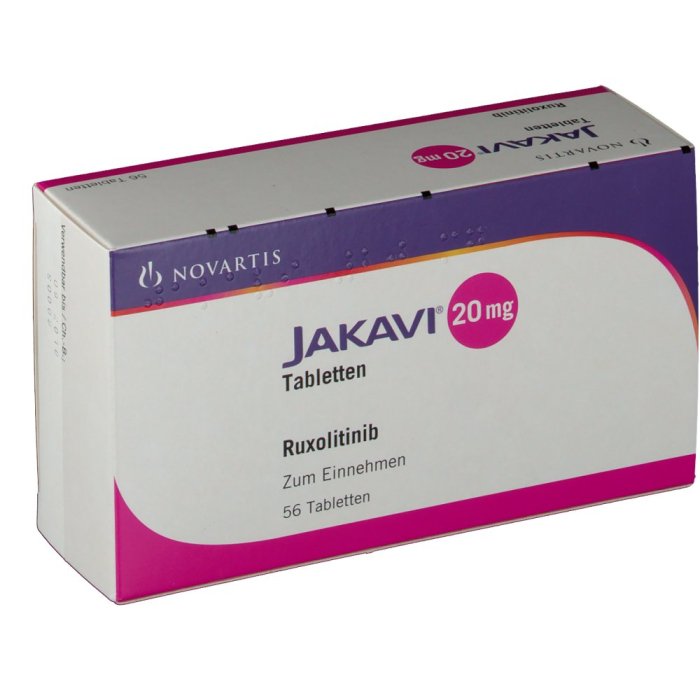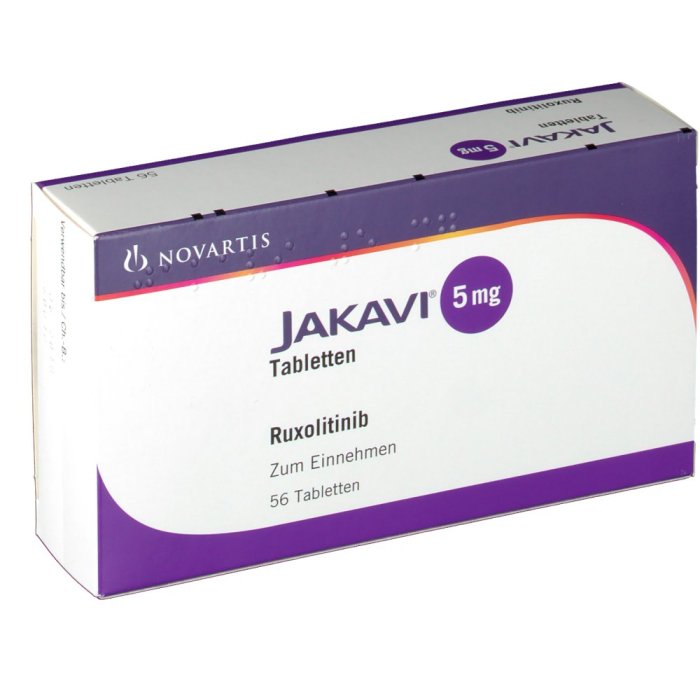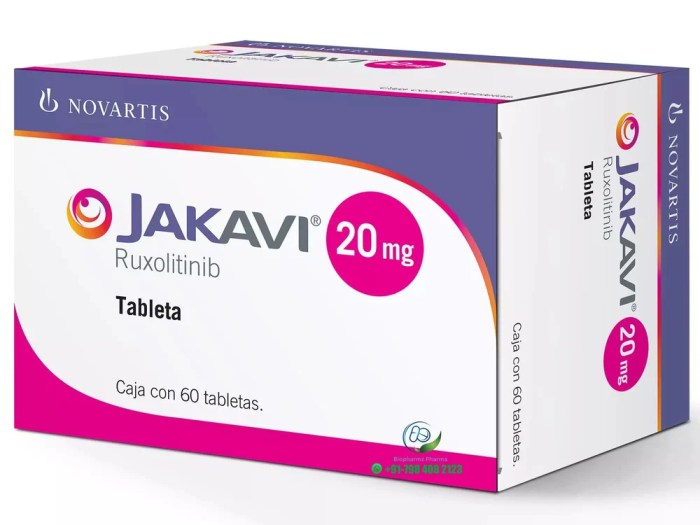Jakavi, also known as ruxolitinib, is a targeted therapy used to treat myelofibrosis (MF) and polycythemia vera (PV), two rare blood cancers. It works by inhibiting the activity of certain enzymes, JAK1 and JAK2, which are involved in cell signaling and growth. Jakavi helps manage symptoms, improve spleen size, and potentially stabilize the disease in patients with MF. In PV, Jakavi reduces red blood cell production and controls symptoms like fatigue, headaches, and itching.
This medication has shown promising results in clinical trials, demonstrating its effectiveness in managing these conditions and improving patient quality of life. However, like any medication, Jakavi comes with potential side effects and risks, which are important to discuss with your healthcare provider.
Jakavi’s Side Effects and Adverse Events

Jakavi (ruxolitinib) is a medication used to treat certain types of blood cancers, including myelofibrosis and polycythemia vera. While effective in managing these conditions, it’s important to be aware of potential side effects and adverse events associated with its use. This section delves into common side effects, potential risks, and strategies for managing adverse events.
Common Side Effects
Common side effects of Jakavi treatment include:
- Low blood cell counts: Jakavi can suppress the production of blood cells, leading to anemia (low red blood cell count), neutropenia (low white blood cell count), and thrombocytopenia (low platelet count). This can increase the risk of infections and bleeding.
- Skin reactions: Some individuals may experience skin reactions like rash, itching, or redness.
- Gastrointestinal issues: Nausea, vomiting, diarrhea, and abdominal pain are common side effects.
- Headache: Headaches are frequently reported by patients taking Jakavi.
- Fatigue: Tiredness and weakness are common side effects, often related to low blood cell counts.
Potential Risks and Complications
While Jakavi offers significant benefits for patients with certain blood cancers, it’s essential to understand potential risks and complications associated with its use:
- Infections: Jakavi’s suppression of white blood cell production can increase the risk of infections. Patients should be vigilant about potential signs of infection and seek medical attention promptly.
- Bleeding: Reduced platelet count due to Jakavi can lead to increased bleeding risk. Patients should be aware of potential bleeding signs and take precautions to minimize the risk.
- Anemia: Jakavi can cause anemia, which can lead to fatigue, weakness, and shortness of breath.
- Hepatotoxicity: In some cases, Jakavi can affect liver function, potentially leading to liver damage.
- Increased risk of thrombosis: Jakavi may increase the risk of blood clots, especially in individuals with pre-existing clotting disorders.
- Tumor lysis syndrome: In rare cases, Jakavi can trigger tumor lysis syndrome, a potentially life-threatening condition that occurs when cancer cells rapidly break down, releasing harmful substances into the bloodstream.
Managing and Mitigating Adverse Events
Healthcare providers closely monitor patients receiving Jakavi treatment to identify and manage potential adverse events. Strategies for managing and mitigating side effects include:
- Regular blood tests: Monitoring blood cell counts and liver function is crucial for early detection and management of potential complications.
- Dose adjustments: If side effects are severe, the Jakavi dosage may be adjusted or temporarily stopped to allow the body to recover.
- Supportive care: Medications and therapies may be used to address specific side effects, such as anemia or infections.
- Lifestyle modifications: Adopting a healthy lifestyle, including a balanced diet, regular exercise, and adequate hydration, can help manage some side effects.
- Open communication: Patients should openly communicate any concerns or changes in their health with their healthcare provider.
Jakavi’s Interactions with Other Medications

Jakavi (ruxolitinib) can interact with other medications, potentially affecting their effectiveness or increasing the risk of side effects. Understanding these interactions is crucial for safe and effective Jakavi treatment.
Importance of Informing Healthcare Providers
It is essential to inform your healthcare provider about all medications and supplements you are taking, including over-the-counter drugs, vitamins, and herbal remedies, before starting Jakavi therapy. This information helps your healthcare provider assess potential drug interactions and adjust your treatment plan accordingly.
Potential Interactions and Consequences
- Strong CYP3A4 Inhibitors: Medications that strongly inhibit the CYP3A4 enzyme, such as ketoconazole, itraconazole, clarithromycin, and ritonavir, can increase Jakavi levels in the blood, potentially increasing the risk of side effects.
- Strong CYP3A4 Inducers: Medications that strongly induce the CYP3A4 enzyme, such as rifampin, carbamazepine, phenytoin, and St. John’s Wort, can decrease Jakavi levels in the blood, potentially reducing its effectiveness.
- Immunosuppressants: Jakavi may increase the risk of infections when used in combination with other immunosuppressants, such as cyclosporine, tacrolimus, and azathioprine.
- Anticoagulants: Jakavi may increase the risk of bleeding when used in combination with anticoagulants, such as warfarin and heparin.
- Other Medications: Jakavi may interact with other medications, including certain chemotherapy drugs, anti-seizure medications, and certain antibiotics.
Impact on Effectiveness and Safety
Interactions between Jakavi and other medications can impact the effectiveness and safety of Jakavi treatment in several ways:
- Increased Side Effects: Interactions can lead to higher Jakavi levels in the blood, increasing the risk of side effects such as anemia, thrombocytopenia, and infections.
- Reduced Effectiveness: Interactions can lower Jakavi levels in the blood, reducing its effectiveness in treating the underlying condition.
- Increased Risk of Complications: Interactions can increase the risk of serious complications, such as bleeding, infections, or organ damage.
Jakavi’s Cost and Accessibility
Jakavi, a medication used to treat myelofibrosis and polycythemia vera, can be a significant financial burden for patients. The cost of Jakavi treatment can vary depending on factors such as insurance coverage, patient affordability, and the availability of financial assistance programs. Understanding the cost of Jakavi and its impact on patient access to therapy is crucial for informed decision-making.
Insurance Coverage and Affordability
Insurance coverage for Jakavi can vary widely. Some insurance plans may cover the full cost of the medication, while others may require patients to pay a significant portion out-of-pocket. The cost of Jakavi can be a major barrier to access for patients with limited financial resources.
- High Out-of-Pocket Costs: Patients with high deductibles or co-pays may struggle to afford Jakavi, even with insurance coverage.
- Prior Authorization Requirements: Many insurance plans require prior authorization before covering Jakavi, which can delay treatment and add to the financial burden.
- Limited Coverage for Off-Label Uses: Insurance coverage for Jakavi may be limited for off-label uses, such as the treatment of other myeloproliferative neoplasms (MPNs).
Financial Assistance Programs
Several financial assistance programs are available to help patients afford Jakavi. These programs may provide co-pay assistance, discounts on the medication, or other forms of financial support.
- Manufacturer Patient Assistance Programs: The manufacturer of Jakavi offers a patient assistance program that provides financial support to eligible patients.
- Non-Profit Organizations: Non-profit organizations, such as the Leukemia & Lymphoma Society, offer financial assistance programs to patients with blood cancers.
- Government Programs: Government programs, such as Medicare and Medicaid, may cover Jakavi, but coverage may be limited depending on the specific program and patient eligibility.
Impact on Healthcare Budgets and Patient Outcomes
The high cost of Jakavi can have a significant impact on healthcare budgets and patient outcomes.
- Increased Healthcare Costs: The use of Jakavi can lead to increased healthcare costs, both for patients and for healthcare systems.
- Delayed or Forgone Treatment: The cost of Jakavi may lead to delayed or forgone treatment for some patients, which can negatively impact their health outcomes.
- Access Disparities: The cost of Jakavi can contribute to access disparities, with patients from low-income backgrounds or with limited insurance coverage being less likely to receive the medication.
Jakavi’s Future in Hematologic Oncology
Jakavi, with its established efficacy in treating myelofibrosis and polycythemia vera, holds significant promise for future advancements in hematologic oncology. Its mechanism of action, targeting JAK1 and JAK2 kinases, presents a unique opportunity for developing personalized medicine approaches and exploring combination therapies to optimize treatment outcomes.
Jakavi’s Potential in Personalized Medicine
Personalized medicine aims to tailor treatments based on an individual’s genetic makeup and disease characteristics. Jakavi’s potential in this field lies in its ability to target specific mutations associated with hematologic malignancies. For instance, the JAK2 V617F mutation is commonly found in myeloproliferative neoplasms, and Jakavi’s effectiveness in treating these patients has been well-documented. Ongoing research is exploring the use of Jakavi in combination with other therapies, such as targeted therapies or immunotherapy, to further enhance its effectiveness in specific patient populations.
Jakavi’s Impact on Patient Quality of Life
Jakavi, a JAK inhibitor, has been shown to be effective in treating myelofibrosis, a rare blood cancer that affects the bone marrow. While Jakavi’s efficacy in managing myelofibrosis is significant, it’s crucial to consider its impact on the quality of life of patients. This includes the potential benefits of symptom relief and improved well-being, as well as the challenges and adjustments that patients may face while undergoing treatment.
Impact on Symptoms and Overall Well-Being
Jakavi can significantly improve the quality of life for patients with myelofibrosis by alleviating symptoms associated with the disease. These symptoms can include fatigue, splenomegaly (enlarged spleen), bone pain, and night sweats. Jakavi can help reduce these symptoms, leading to improved energy levels, better sleep quality, and a more comfortable overall experience.
Psychosocial and Emotional Aspects of Living with Myelofibrosis, Jakavi
Living with a chronic hematologic condition like myelofibrosis can present significant psychosocial and emotional challenges. Patients may experience anxiety, depression, and feelings of isolation. Jakavi’s role in managing these challenges is multifaceted. By improving symptoms and providing a sense of control over the disease, Jakavi can positively impact patients’ emotional well-being. Additionally, the support and guidance provided by healthcare professionals, including oncologists, nurses, and support groups, can help patients cope with the emotional and psychosocial aspects of living with myelofibrosis.
Jakavi’s Impact on Work, Social Activities, and Overall Quality of Life
Jakavi’s impact on patients’ work, social activities, and overall quality of life is complex and can vary depending on individual circumstances. For some patients, Jakavi may allow them to maintain their current lifestyle and participate in work and social activities more comfortably. For others, Jakavi may necessitate adjustments to their routines and lifestyle choices. It’s essential for patients to discuss their individual circumstances with their healthcare providers to develop a personalized treatment plan that considers their specific needs and goals.
Jakavi’s Role in the Management of Myelofibrosis
Jakavi (ruxolitinib) is a medication that has revolutionized the treatment of myelofibrosis, a rare and serious bone marrow disorder. It works by inhibiting the activity of Janus kinase (JAK) enzymes, which are involved in the signaling pathways that contribute to the development of myelofibrosis.
Benefits of Jakavi in Myelofibrosis
Jakavi offers several benefits for patients with myelofibrosis, including symptom relief, improved spleen size, and potential for disease stabilization.
- Symptom Relief: Jakavi effectively reduces the symptoms of myelofibrosis, such as fatigue, night sweats, bone pain, and itching. This improvement in quality of life is a significant benefit for patients.
- Improved Spleen Size: Myelofibrosis often leads to an enlarged spleen, which can cause discomfort and complications. Jakavi has been shown to significantly reduce spleen size in many patients, leading to improved symptom management and overall well-being.
- Disease Stabilization: While Jakavi does not cure myelofibrosis, it can help to stabilize the disease, preventing its progression and delaying the need for more aggressive treatments. This stabilization can provide patients with a longer period of symptom control and improved quality of life.
Comparison of Jakavi to Other Therapies
Jakavi is considered a first-line treatment for myelofibrosis, and its effectiveness has been compared to other therapies, such as hydroxyurea and ruxolitinib.
- Hydroxyurea: Hydroxyurea is a traditional treatment for myelofibrosis, but it has been shown to be less effective than Jakavi in reducing spleen size and improving symptoms.
- Ruxolitinib: Ruxolitinib, like Jakavi, is a JAK inhibitor, but it is approved for the treatment of polycythemia vera and essential thrombocythemia, not myelofibrosis. However, both Jakavi and ruxolitinib have demonstrated efficacy in managing myelofibrosis symptoms.
Role of Jakavi in Delaying Disease Progression and Improving Survival
While further research is ongoing, preliminary studies suggest that Jakavi may play a role in delaying disease progression and potentially improving survival in patients with myelofibrosis.
- Disease Progression: Studies have shown that Jakavi can significantly reduce the rate of disease progression in myelofibrosis, delaying the need for more intensive treatments.
- Survival: While more research is needed to confirm its impact on overall survival, some studies have indicated that Jakavi may be associated with improved survival rates in patients with myelofibrosis.
Jakavi’s Role in the Management of Polycythemia Vera

Jakavi, also known as ruxolitinib, is a JAK1/JAK2 inhibitor that plays a significant role in managing Polycythemia Vera (PV), a chronic myeloproliferative neoplasm characterized by an overproduction of red blood cells.
Jakavi’s effectiveness in managing PV stems from its ability to reduce the production of red blood cells by inhibiting the JAK-STAT signaling pathway, a key pathway involved in the development and progression of PV. This reduction in red blood cell production helps control the symptoms associated with PV, such as fatigue, headaches, and itching.
Benefits of Jakavi Compared to Other Therapies for Polycythemia Vera
Jakavi offers several potential benefits compared to other therapies for PV, such as phlebotomy and hydroxyurea.
- Improved Symptom Control: Jakavi has been shown to effectively control PV symptoms, including fatigue, headaches, and itching, often leading to a better quality of life for patients.
- Reduced Phlebotomy Requirements: Jakavi can significantly reduce the need for phlebotomy, a procedure to remove excess blood, which can be inconvenient and potentially lead to iron deficiency.
- Alternative to Hydroxyurea: Jakavi provides an alternative treatment option for patients who cannot tolerate or are resistant to hydroxyurea, a common first-line therapy for PV.
- Potential for Long-Term Management: While long-term studies are ongoing, Jakavi shows promise as a long-term management option for PV, offering sustained control of symptoms and disease progression.
Jakavi’s Role in Reducing the Risk of Complications Associated with Polycythemia Vera
PV can lead to serious complications, such as thrombosis (blood clots) and stroke, due to the increased viscosity of the blood caused by the overproduction of red blood cells. Jakavi plays a crucial role in reducing the risk of these complications by:
- Reducing Blood Viscosity: By reducing the production of red blood cells, Jakavi lowers the viscosity of the blood, making it less prone to clotting.
- Controlling Thrombotic Events: Clinical studies have shown that Jakavi can significantly reduce the risk of thrombotic events, including deep vein thrombosis and pulmonary embolism.
- Minimizing Stroke Risk: By controlling blood viscosity and reducing the risk of thrombosis, Jakavi helps minimize the risk of stroke in PV patients.
Jakavi represents a significant advancement in the treatment of myelofibrosis and polycythemia vera. Its targeted mechanism of action, coupled with its proven efficacy, offers hope for patients battling these challenging conditions. Ongoing research continues to explore its potential in other hematologic malignancies and its use in combination therapies. As with any treatment, understanding the potential benefits and risks is crucial for informed decision-making.
Jakavi is a medication used to treat certain types of cancer, including myelofibrosis and polycythemia vera. It works by targeting a specific enzyme involved in cell growth and development. Similar to Jakavi, Trulicity, a medication for type 2 diabetes, trulicity , is also designed to regulate specific processes in the body, but for glucose metabolism rather than cell growth.
Both medications have a targeted approach to treating their respective conditions, highlighting the advancements in medical science.